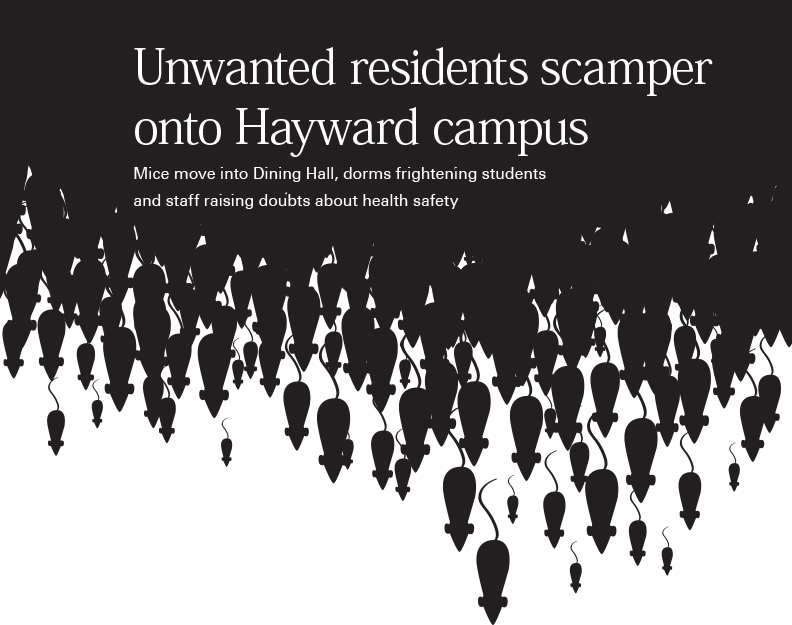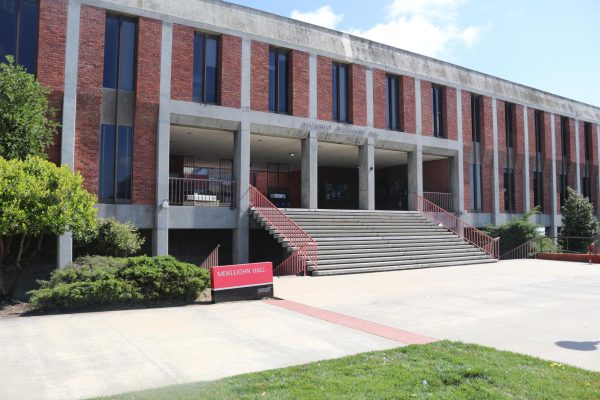Unwanted residents scamper onto Hayward campus
October 26, 2016
At 2:30 a.m. on Oct. 3, Cal State East Bay freshman Briana Secaira returned from a trip to Los Angeles to her four-bedroom dorm on the second floor of the Juniper residence hall on East Bay’s Hayward campus. She noticed that her items were moved while she had been gone and mouse traps had been placed on her desk.
As Secaira began to unpack, she heard squealing and assumed it was outside until she saw a mouse caught in a trap near her bed. “It’s like two in the morning and I just came from a long drive,” said Secaira. “I just want to go to sleep and I hear a mouse, so I ran outside crying because I have nowhere to sleep. I don’t want to sleep in there. It’s nasty.”
After the incident, Secaira and her roommates filed a campus maintenance request on the student housing website. Maintenance covered the holes in their walls with blue painter’s tape and pieces of a blind used for windows so mice couldn’t get through, according to Secaira.
Less than a week before the incident, on Sept. 28, student housing sent an email to freshman residents in the Juniper and Sequoia residence halls, notifying them about a rodent invasion in the dorms. The email stated, “Student Housing is also working with the University’s Facilities department to identify areas around the buildings where mice can get in and working on ways to prevent the intrusion. We are also looking at installing and modifying some of the door openings.”
Two main things may have contributed to the presence of more mice on campus, according to Mark Almeida, interim director of housing: the California drought and campus construction. “We’re in a drought in California, so the field mice are looking for vegetation, some sort of wet ground, and they tend to come towards [places] that are hydrated, like planting beds,” Almeida said.
Construction on campus over the summer also likely caused the shaking ground to displace the mice. Two parking lots near the RAW center were re-paved, so all nearby vegetation was removed, according to Almeida.
“When all of that is going on, the mice needed somewhere to go,” said Kelvin Pace, custodial grounds manager on campus. “They’ve come to a place of shelter, if you will, and so this isn’t just happening in student housing, but the campus.”
Pace said they can get rid of the mice in one building but they can easily migrate to other buildings.
“I had to go walk around some of the buildings in housing,” said Pace. “I saw people leave food out instead of putting them in tupperwares. [Mice] have a high sense of smell, people don’t know that. So not putting things in just a regular store-bought container like bread, bagels, and whatever… they’re going to go after it.”
Housing has been supplied with glue mouse traps from Applied Pest Management, who they have a contract with through the facilities department.
Pace said glue traps are the most humane way to dispose of mice and are safer than exposing humans and animals to poisonous pest control. “We don’t want to use poison because they can die somewhere in the walls too and you’ll have a bad smell,” Pace said. “It’s random, they’re everywhere now — the RAW, different buildings — they’re kinda like gypsies.”
An anonymous source told the Pioneer that a resident assistant was bitten by a mouse in September and was given a contract by housing to not speak about it. Almeida confirmed that a housing employee was injured and, consistent with university protocol, was taken to the hospital immediately and was given an injury form to fill out, which can be found on the Risk Management website.
Another anonymous source told The Pioneer there have been sightings of mice and feces in the Dining Commons. Workers have allegedly been told to deny the sightings if asked by visitors. Mike Lee, manager of Dining Commons, declined to comment.
On Oct. 12, freshman Nev Briones came home to her room in the Sequoia residence hall and found mice feces on her desk. “It’s our parents’ money, you know. I don’t live with mice at home, I shouldn’t have to be paying $12,000 a year to live with mice here,” Briones said.
Mice can carry transmitted viruses, diseases and bacteria and their feces should be handled with gloves and a facemask, according to pest control service, Orkins.com.
Pace said they’ve received no reports on contamination despite pest control being on campus every single day to do rounds due to the high volume of mice sightings.
















